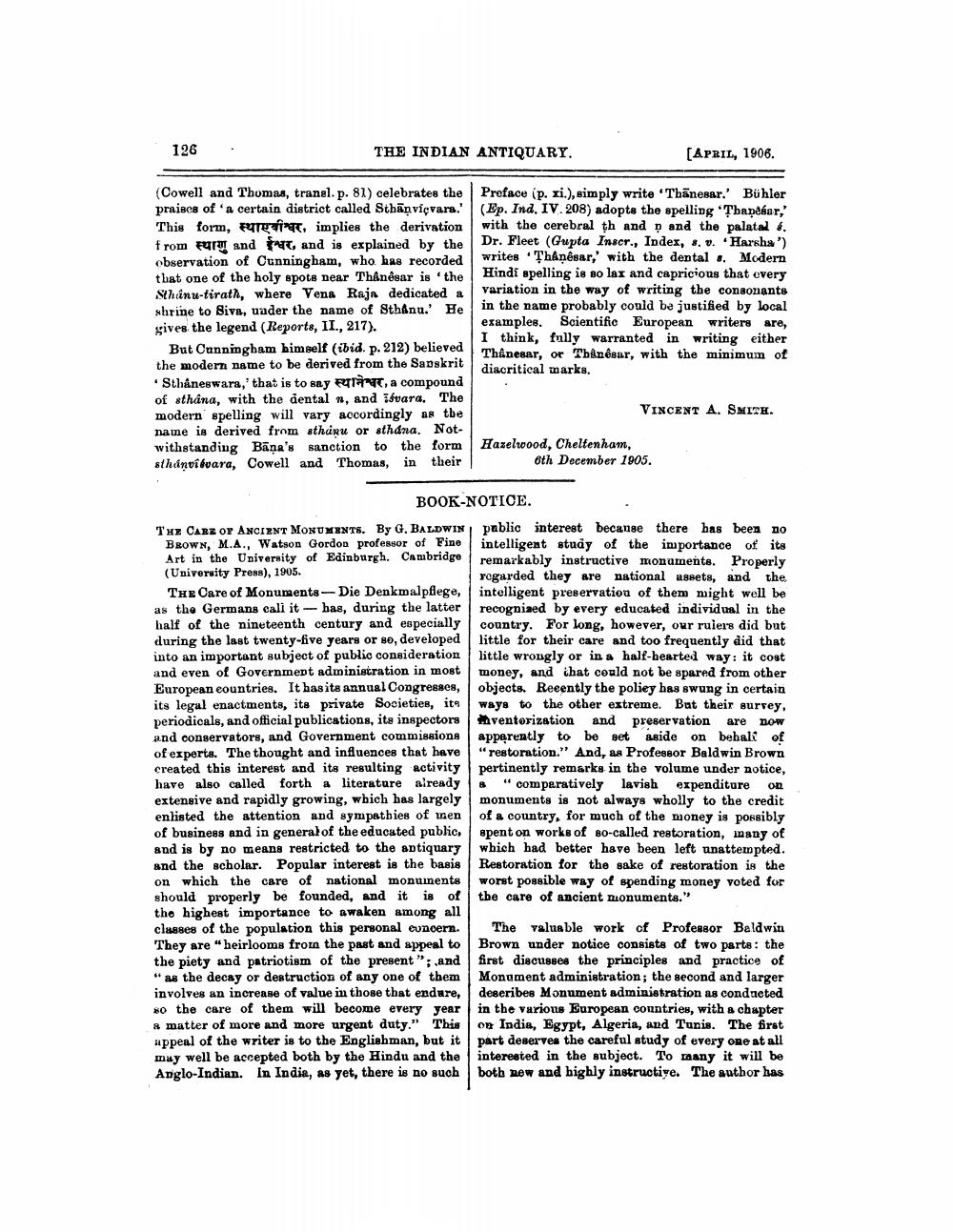________________
126
THE INDIAN ANTIQUARY.
(Cowell and Thomas, transl. p. 81) celebrates the praises of a certain district called Sthanviçvara.' This form, g, implies the derivation from ur and, and is explained by the observation of Cunningham, who has recorded that one of the holy spots near Thânêsar is the Sthanu-tirath, where Vena Raja dedicated a shrine to Siva, under the name of Sthânu.' He gives the legend (Reports, II., 217).
But Cunningham himself (ibid. p. 212) believed the modern name to be derived from the Sanskrit Sthâneswara,' that is to say Fur, a compound of sthâna, with the dental n, and isvara. The modern spelling will vary accordingly as the name is derived from sthanu or sthana. Notwithstanding Bana's sanction to the form sthanviévara, Cowell and Thomas, in their
THE CARE OF ANCIENT MONUMENTS. By G. BALDWIN BROWN, M.A., Watson Gordon professor of Fine Art in the University of Edinburgh. Cambridge (University Press), 1905.
[APRIL, 1906.
Preface (p. xi.), simply write 'Thanesar.' Bühler (Ep. Ind, IV. 208) adopts the spelling 'Thapêéar,' with the cerebral th and p and the palatal é. Dr. Fleet (Gupta Inscr., Index, s. v. Harsha") writes Thanêsar,' with the dental s. Modern Hindi spelling is so lax and capricious that every variation in the way of writing the consonants in the name probably could be justified by local examples. Scientific European writers are, I think, fully warranted in writing either Thanesar, or Thanesar, with the minimum of diacritical marks.
BOOK-NOTICE.
THE Care of Monuments- Die Denkmalpflege, as the Germans call it has, during the latter half of the nineteenth century and especially during the last twenty-five years or so, developed into an important subject of public consideration and even of Government administration in most European countries. It has its annual Congresses, its legal enactments, its private Societies, its periodicals, and official publications, its inspectors and conservators, and Government commissions of experts. The thought and influences that have created this interest and its resulting activity have also called forth a literature already extensive and rapidly growing, which has largely enlisted the attention and sympathies of men of business and in general of the educated public, and is by no means restricted to the antiquary and the scholar. Popular interest is the basis on which the care of national monuments should properly be founded, and it is of the highest importance to awaken among all classes of the population this personal concern. They are "heirlooms from the past and appeal to the piety and patriotism of the present"; and "as the decay or destruction of any one of them involves an increase of value in those that endure, so the care of them will become every year a matter of more and more urgent duty." This appeal of the writer is to the Englishman, but it may well be accepted both by the Hindu and the Anglo-Indian. In India, as yet, there is no such
VINCENT A. SMITH.
Hazelwood, Cheltenham, 6th December 1905.
public interest because there has been no intelligent study of the importance of its remarkably instructive monuments. Properly regarded they are national assets, and the intelligent preservation of them might well be recognized by every educated individual in the country. For long, however, our rulers did but little for their care and too frequently did that little wrongly or in a half-hearted way: it cost money, and that could not be spared from other objects. Recently the poliey has swung in certain ways to the other extreme. But their survey,
ventorization and preservation are now apparently to be set aside on behalf of "restoration." And, as Professor Baldwin Brown pertinently remarks in the volume under notice, a" comparatively lavish expenditure on monuments is not always wholly to the credit of a country, for much of the money is possibly spent on works of so-called restoration, many of which had better have been left unattempted. Restoration for the sake of restoration is the worst possible way of spending money voted for the care of ancient monuments."
The valuable work of Professor Baldwin Brown under notice consists of two parts: the first discusses the principles and practice of Monument administration; the second and larger deseribes Monument administration as conducted in the various European countries, with a chapter on India, Egypt, Algeria, and Tunis. The first part deserves the careful study of every one at all interested in the subject. To many it will be both new and highly instructive. The author has




